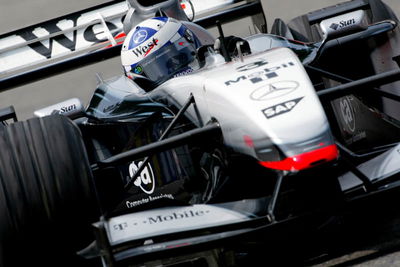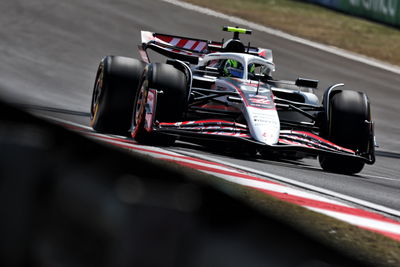Undercover in the pit-lane.
During practice at a Grand Prix the Lucky Strike BAR Honda pit is always a hive of activity as everyone rushes around the garage. Each man has his own job and his own set routine, and there's not a spare pair of hand to be seen.
But while the rest of the crew is working feverishly around the car, one key team member is stationed far away at the other end of the pit-lane.
During practice at a Grand Prix the Lucky Strike BAR Honda pit is always a hive of activity as everyone rushes around the garage. Each man has his own job and his own set routine, and there's not a spare pair of hand to be seen.
But while the rest of the crew is working feverishly around the car, one key team member is stationed far away at the other end of the pit-lane.
Not only is Martin Pople not working on or around a Lucky Strike BAR Honda, he's not even interested in what they are doing. In fact he's the team's very own 007 and his job is to keep an eye on what everyone else is up to.
Pope's day job is Team Co-ordinator and his responsibilities extend to a myriad of logistical and administrative tasks. But when the cars are running in practice the 39-year-old takes on his 'undercover' role as team spy. It's hardly cloak and dagger stuff though. He wears team uniform and stands in full view of everyone in the pit-lane. The other teams know exactly who he is and why he's there. And what's more, they all have 'spies' of their own. So what's it all about?
Pope is Lucky Strike B.A.R Honda's tyre spotter. On their own, practice times are almost meaningless unless you know or can guess what a rival team is up to. While you can never be sure how much fuel is in the tank of a particular car, you can keep track of when a driver heads out on a fresh set of rubber, and if possible, which of the two available Bridgestone or Michelin compounds he's using. Such information is used by Lucky Strike BAR Honda engineers to put the team's own performance into context.
"Basically we're looking at all the other teams and what tyres they're running," Martin explains. "I feed back information to the team manager and the engineers on the pit wall. When another car goes out on new tyres, they compare the times on the screen to times they've done on a used set of tyres and work out the relationship between them."
Every driver has three sets of tyres to play with on Friday and he can use any combination of the two compounds on offer, known as the option and the prime. Often teams will have a good idea of which one will suit their cars, but will usually try both nonetheless.
At the end of Friday all those tyres are removed from the equation and each driver then has seven new sets to use for the rest of the weekend. On Saturday morning the process of comparing the two compounds might continue before a choice is made between the two. That type of tyre then has to be used for both qualifying and the race. It's a critical choice, because usually one tyre might have a better performance for qualifying than the race and vice versa. Knowing what other people are doing helps the team to make its decision.
Pope is not the only spy in the pit-lane - every team has at least one. But Pope and representatives from most of the other teams usually stand in a huddle at the less fashionable pit-lane exit, so they can keep track of every car. As soon as somebody slips on a fresh set, Martin sends a radio message to the team's garage. And at the end of the session he hands over a definitive list, which the engineers cross reference with lap times to see who is genuinely and consistently quick and who just popped in a one-off quick lap with a brand new set of tyres.
Pope has to check two things - when a driver is on a new set, and if possible, whether it is the option or the prime. The first question is relatively easy to answer, because new tyres have a shiny appearance that is apparent as the car leaves the pit, but wears off as soon as it takes to the track.
"A new tyre is not too difficult to spot, although sometimes it is harder in a dirty pit-lane because the tyres lose their shine quickly. It's when they start mixing new rears and old fronts that it gets really complicated, as has happened a lot this year! The other difficult one is when they start running wet tyres - there are variations of different wets that are sometimes difficult to tell apart."
Spotting the compounds is not straightforward, because naturally teams try to hide the information.
"It's very difficult! With some teams it's easy but with others it's very hard. Ferrari and McLaren are very difficult to spy on. There's two ways to tell. There's a black stamp on the tyre, so when the car stops you look to see if you can read it. It's very difficult to see from a distance."
"The second way is by the Bridgestone number written in pen on the side of the tyre. Some teams cover that up, including ourselves, Ferrari and McLaren, but sometimes the tape will come off, so you're looking all the time in case it does!"
If a driver stops to do a practice start at the pit exit, the tyre spotters may be able to get a decent glimpse. The other time they can have a close look is when all the cars line-up together when a session starts or is re-started after a red flag. However, it's usually impossible for one guy to do every car on his own, so the rival spotters often actually pool information and check each other's notes if they think they've missed something.
"Every day you're doing the same job, so you help each other out. You've got some of the TV people doing the same thing, so we compare notes with them as well."
There's no question that the information on what other people are doing plays an important role in determining Lucky Strike BAR Honda's own strategy for the weekend.
"It is quite useful. For example in Hungary, Ferrari and McLaren decided to go on to the harder option tyre and the team wouldn't have really known that until later. So that was important."
Ironically during the all-important qualifying session the job becomes redundant. By then teams have usually worked out what tyre compounds their rivals have chosen, and everyone is running four new sets of tyres in order to squeeze out the best lap time.
Does Pope ever feel a bit guilty about what he does?
"You do! I know most of the people up and down the pit-lane. They don't really mind too much, because they know they've got someone doing the same thing. But sometimes they stand in front of you for a laugh, or say something funny..."











